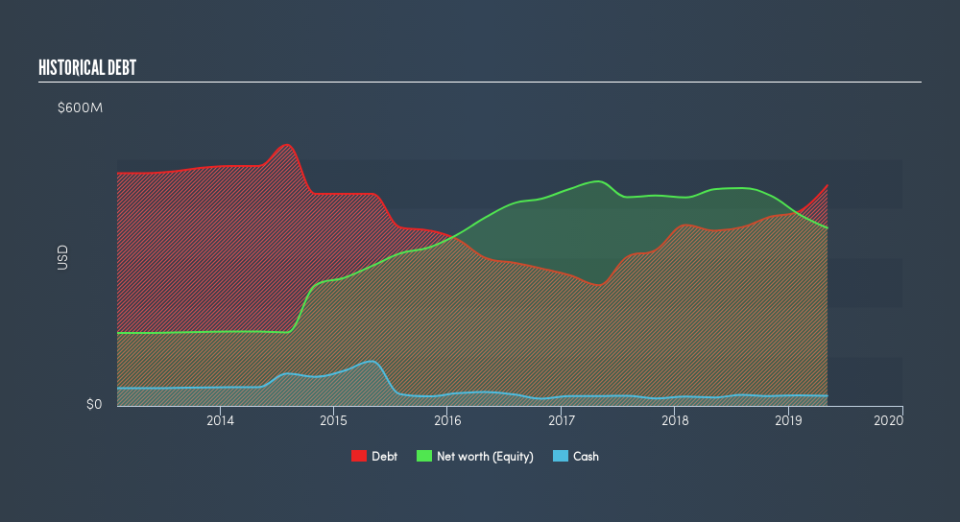Dave & Buster's Entertainment (NASDAQ:PLAY) Has A Somewhat Strained Balance Sheet

Warren Buffett famously said, 'Volatility is far from synonymous with risk.' It's only natural to consider a company's balance sheet when you examine how risky it is, since debt is often involved when a business collapses. We note that Dave & Buster's Entertainment, Inc. (NASDAQ:PLAY) does have debt on its balance sheet. But should shareholders be worried about its use of debt?
When Is Debt Dangerous?
Debt assists a business until the business has trouble paying it off, either with new capital or with free cash flow. In the worst case scenario, a company can go bankrupt if it cannot pay its creditors. While that is not too common, we often do see indebted companies permanently diluting shareholders because lenders force them to raise capital at a distressed price. Having said that, the most common situation is where a company manages its debt reasonably well - and to its own advantage. The first step when considering a company's debt levels is to consider its cash and debt together.
View our latest analysis for Dave & Buster's Entertainment
What Is Dave & Buster's Entertainment's Net Debt?
You can click the graphic below for the historical numbers, but it shows that as of May 2019 Dave & Buster's Entertainment had US$446.3m of debt, an increase on US$354.6m, over one year. However, because it has a cash reserve of US$20.4m, its net debt is less, at about US$425.9m.
A Look At Dave & Buster's Entertainment's Liabilities
According to the last reported balance sheet, Dave & Buster's Entertainment had liabilities of US$259.1m due within 12 months, and liabilities of US$1.55b due beyond 12 months. Offsetting these obligations, it had cash of US$20.4m as well as receivables valued at US$1.09m due within 12 months. So it has liabilities totalling US$1.78b more than its cash and near-term receivables, combined.
When you consider that this deficiency exceeds the company's US$1.48b market capitalization, you might well be inclined to review the balance sheet, just like one might study a new partner's social media. In the scenario where the company had to clean up its balance sheet quickly, it seems likely shareholders would suffer extensive dilution.
We use two main ratios to inform us about debt levels relative to earnings. The first is net debt divided by earnings before interest, tax, depreciation, and amortization (EBITDA), while the second is how many times its earnings before interest and tax (EBIT) covers its interest expense (or its interest cover, for short). This way, we consider both the absolute quantum of the debt, as well as the interest rates paid on it.
Dave & Buster's Entertainment's net debt to EBITDA ratio of about 1.5 suggests only moderate use of debt. And its strong interest cover of 11.0 times, makes us even more comfortable. Sadly, Dave & Buster's Entertainment's EBIT actually dropped 3.8% in the last year. If earnings continue on that decline then managing that debt will be difficult like delivering hot soup on a unicycle. There's no doubt that we learn most about debt from the balance sheet. But ultimately the future profitability of the business will decide if Dave & Buster's Entertainment can strengthen its balance sheet over time. So if you want to see what the professionals think, you might find this free report on analyst profit forecasts to be interesting.
Finally, while the tax-man may adore accounting profits, lenders only accept cold hard cash. So it's worth checking how much of that EBIT is backed by free cash flow. Looking at the most recent three years, Dave & Buster's Entertainment recorded free cash flow of 41% of its EBIT, which is weaker than we'd expect. That weak cash conversion makes it more difficult to handle indebtedness.
Our View
Mulling over Dave & Buster's Entertainment's attempt at staying on top of its total liabilities, we're certainly not enthusiastic. But on the bright side, its interest cover is a good sign, and makes us more optimistic. Looking at the balance sheet and taking into account all these factors, we do believe that debt is making Dave & Buster's Entertainment stock a bit risky. Some people like that sort of risk, but we're mindful of the potential pitfalls, so we'd probably prefer it carry less debt. Over time, share prices tend to follow earnings per share, so if you're interested in Dave & Buster's Entertainment, you may well want to click here to check an interactive graph of its earnings per share history.
Of course, if you're the type of investor who prefers buying stocks without the burden of debt, then don't hesitate to discover our exclusive list of net cash growth stocks, today.
We aim to bring you long-term focused research analysis driven by fundamental data. Note that our analysis may not factor in the latest price-sensitive company announcements or qualitative material.
If you spot an error that warrants correction, please contact the editor at editorial-team@simplywallst.com. This article by Simply Wall St is general in nature. It does not constitute a recommendation to buy or sell any stock, and does not take account of your objectives, or your financial situation. Simply Wall St has no position in the stocks mentioned. Thank you for reading.

 Yahoo Movies
Yahoo Movies 

